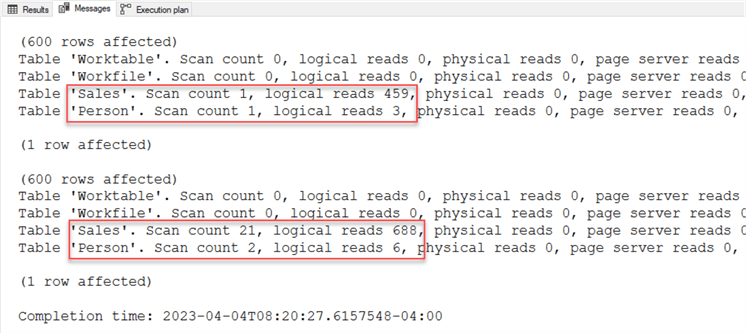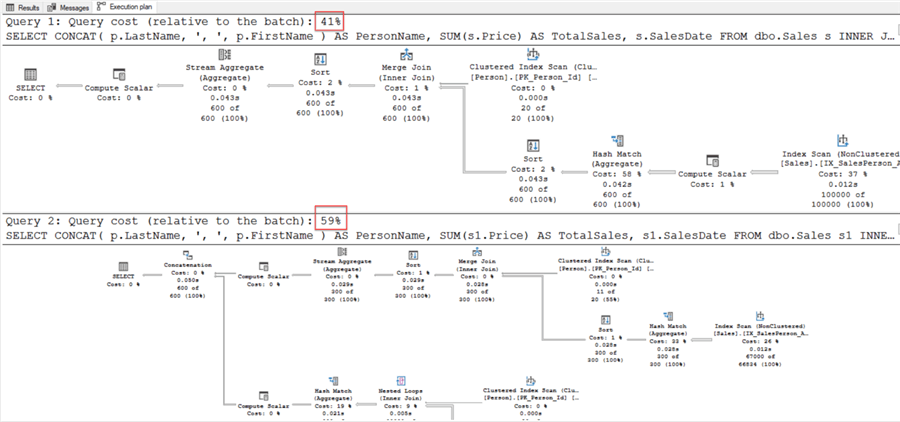By: Jared Westover | Updated: 2023-05-17 | Comments (7) | Related: 1 | 2 | 3 | 4 | 5 | 6 | 7 | > TSQL
Problem
Have you ever heard: "Never place a CASE expression in a JOIN clause?" I know I have. It's one of those best practices handed down by the SQL elders of old. I'm all for following guidelines, but sometimes I like to know why I'm doing something. Not just because someone wrote a blog article 20 years ago and it's the first one that shows up in search results. Stay tuned if you're like me, and don't follow advice blindly.
Solution
In this tutorial, we'll look at the many uses of a CASE expression. Additionally, why would you use a CASE expression in a JOIN clause? Next, I'll explore a common alternative that may or may not provide better performance. Finally, we'll answer the questions like "Should you never use a CASE expression in a JOIN clause?" My answer might surprise you.
Exploring SQL CASE
You're missing out if you've never used a CASE expression. It's the next command to learn after SELECT *. You might describe it as the MacGyver of T-SQL. Microsoft defines CASE as an expression that evaluates a list of conditions and returns one of the multiple possible result expressions. Said another way: Tell SQL that if this condition is true, then return this other thing.
SELECT CASE
WHEN 1 = 1 THEN
1
WHEN 2 = 2 THEN
2
WHEN 3 = 3 THEN
3
ELSE
0
END AS [My Favorite Number];
Before moving on, try and answer the questions in the example above. What results will SQL Server return and why?
If you feel extra motivation, you can nest CASE expressions for added control. I'm not a fan of doing this if it makes code harder to follow. I would rather repeat certain parts. I know there is an adage of DRY ("Don't Repeat Yourself."), which, for the most part, I agree with.
Below is an example of a nested CASE expression. Doesn't that look lovely? If I put more effort in, I could clean it up. However, I use Redgate SQL Prompt to format all my code, including the example below.
SELECT CASE
WHEN 1 = 1 THEN
CASE
WHEN 2 = 2 THEN
CASE
WHEN 3 = 3 THEN
3
ELSE
0
END
ELSE
0
END
ELSE
0
END AS [My Second Favorite Number];
There are a few other places where you see CASE expressions; the first is in a WHERE clause:
SELECT Column3
FROM dbo.SpecialTable
WHERE CASE
WHEN Column3 = 'Hello' THEN
1
WHEN Column3 = 'Goodbye' THEN
2
ELSE
0
END > 0;
And finally, in the example below, I've added it to the JOIN clause:
SELECT t1.Column1,
t1.Column2,
t2.Column3
FROM Table1 t1
INNER JOIN SpecialTable t2
ON CASE
WHEN t2.Column3 = 'Hello' THEN
1
WHEN t2.Column3 = 'Goodbye' THEN
2
ELSE
0
END = t1.JoinColumn;
As I mentioned above, people might frown on the second more than the first. I've seen it written on several "you should never do" lists.
Build Our Dataset
Let's create a dataset where using a CASE expression in a JOIN makes sense. I'll add two tables: Person and Sales.
CREATE TABLE dbo.Person
(
Id INT NOT NULL,
FirstName NVARCHAR(200) NOT NULL,
LastName NVARCHAR(200) NOT NULL,
IsActive BIT NOT NULL
CONSTRAINT PK_Person_Id
PRIMARY KEY CLUSTERED (Id)
);
CREATE TABLE dbo.Sales
(
Id INT IDENTITY(1, 1) NOT NULL,
SalesDate DATE NOT NULL,
OrderCode NVARCHAR(3) NOT NULL,
Quantity INT NOT NULL,
Price DECIMAL(6, 0) NOT NULL,
SalesPersonId INT NOT NULL,
AccountManagerId INT NULL,
CONSTRAINT PK_Sales_Id
PRIMARY KEY CLUSTERED (Id),
CONSTRAINT FK_Sales_SalesPerson
FOREIGN KEY (SalesPersonId)
REFERENCES dbo.Person (Id),
CONSTRAINT FK_Sales_AccountManager
FOREIGN KEY (AccountManagerId)
REFERENCES dbo.Person (Id)
);
GO
Now, let's add some data to each of them. For the Person table, we'll insert 20 rows. For the Sales table, we'll insert 100,000 rows. I want at least one table to be on the larger side.
INSERT INTO dbo.Person
(
Id,
FirstName,
LastName,
IsActive
)
VALUES
(1, 'John', 'Smith', 1),
(2, 'Sarah', 'Johnson', 1),
(3, 'Michael', 'Williams', 1),
(4, 'Emily', 'Brown', 1),
(5, 'David', 'Jones', 1),
(6, 'Emma', 'Garcia', 1),
(7, 'Daniel', 'Martinez', 1),
(8, 'Olivia', 'Davis', 1),
(9, 'Matthew', 'Rodriguez', 1),
(10, 'Ava', 'Miller', 1),
(11, 'Christopher', 'Gonzalez', 1),
(12, 'Sophia', 'Wilson', 1),
(13, 'Andrew', 'Anderson', 1),
(14, 'Isabella', 'Thomas', 1),
(15, 'Joshua', 'Jackson', 1),
(16, 'Mia', 'White', 1),
(17, 'William', 'Harris', 1),
(18, 'Charlotte', 'Clark', 1),
(19, 'Ethan', 'Lewis', 1),
(20, 'Amelia', 'Lee', 1);
WITH SalesData AS (
SELECT TOP 100000
DATEADD(DAY, RAND(CHECKSUM(NEWID())) * (1 + DATEDIFF(DAY, '2023-04-01', '04-30-2023')), '2023-04-01') AS SalesDate,
CASE
WHEN (ROW_NUMBER() OVER (ORDER BY (SELECT NULL))) % 3 = 0 THEN 'ABC'
WHEN (ROW_NUMBER() OVER (ORDER BY (SELECT NULL))) % 3 = 1 THEN 'DEF'
ELSE 'GHI'
END AS OrderCode,
ABS(CHECKSUM(NEWID()) % 100) + 1 AS Quantity,
ABS(CHECKSUM(NEWID()) % 1000) + 100 AS Price,
ABS(CHECKSUM(NEWID()) % 10) + 1 AS SalesPersonId,
CASE
WHEN (ROW_NUMBER() OVER (ORDER BY (SELECT NULL))) % 100 = 0 THEN NULL
ELSE ABS(CHECKSUM(NEWID()) % 10) + 11
END AS AccountManagerId
FROM sys.all_columns cl1
CROSS JOIN sys.all_columns cl2
)
-- Insert the data into the dbo.Sales table
INSERT INTO dbo.Sales
(
SalesDate,
OrderCode,
Quantity,
Price,
SalesPersonId,
AccountManagerId
)
SELECT SalesDate,
OrderCode,
Quantity,
Price,
SalesPersonId,
AccountManagerId
FROM SalesData;
We always populate the SalesPersonId in the Sales table. The AccountManagerId column is sometimes populated. You can see that the SalesPersonId and AccountManagerId are foreign keys back to the Person table.
Why Use a CASE Expression in a JOIN?
Why would you use a CASE in a JOIN clause in the first place? One reason is if you have some complex join logic you're trying to implement, essentially joining a table based on multiple conditions. For example, we want to join our Person and Sales tables primarily on the SalesPersonId. However, when the OrderCode has a specific value, we want to join on the AccountManagerId.
SELECT CONCAT( p.LastName,
', ',
p.FirstName
) AS PersonName,
SUM(s.Price) AS TotalSales,
s.SalesDate
FROM dbo.Sales s
INNER JOIN dbo.Person p
ON p.Id = CASE
WHEN s.OrderCode = 'ABC'
AND s.AccountManagerId IS NOT NULL THEN
s.AccountManagerId
ELSE
s.SalesPersonId
END
GROUP BY s.SalesDate,
p.FirstName,
p.LastName;
Another reason for using CASE is to handle NULLs returned from one of the tables. Of course, this is when an ISNULL() doesn't provide the results you're looking for.
SELECT CONCAT( p.LastName,
', ',
p.FirstName
) AS PersonName,
SUM(s.Price) AS TotalSales,
s.SalesDate
FROM dbo.Sales s
INNER JOIN dbo.Person p
ON p.Id = CASE
WHEN s.AccountManagerId IS NULL THEN
1
WHEN s.AccountManagerId IS NULL
AND s.SalesDate > '2023-04-05' THEN
2
ELSE
s.SalesPersonId
END
GROUP BY s.SalesDate,
p.FirstName,
p.LastName;
I'm sure there are other examples, but these two seem to come up the most.
Alternatives to CASE
We have yet to look at the performance of CASE versus another method. However, how can we accomplish the same results differently by not using a CASE expression? The one I see recommended the most is using a UNION ALL operator. That's the one we'll compare against.
Below is how you would write a statement to avoid using the CASE. The UNION ALL creates two datasets that match the join criteria and then combines them.
SELECT CONCAT( p.LastName,
', ',
p.FirstName
) AS PersonName,
SUM(s1.Price) AS TotalSales,
s1.SalesDate
FROM dbo.Sales s1
INNER JOIN dbo.Person p
ON p.Id = s1.SalesPersonId
WHERE s1.OrderCode <> 'ABC'
OR s1.AccountManagerId IS NULL
GROUP BY s1.SalesDate,
p.FirstName,
p.LastName
UNION ALL
SELECT CONCAT( p.LastName,
', ',
p.FirstName
) AS PersonName,
SUM(s2.Price) AS TotalSales,
s2.SalesDate
FROM dbo.Sales s2
INNER JOIN dbo.Person p
ON p.Id = s2.AccountManagerId
WHERE s2.OrderCode = 'ABC'
AND s2.AccountManagerId IS NOT NULL
GROUP BY s2.SalesDate,
p.FirstName,
p.LastName;
One thing to remember is that the above method goes against the DRY philosophy. Not that I advocate following the philosophy to a T.
Comparing Performance
Now it's time to compare both methods and see if one performs better. Before we do that, I'm going to create three indexes. The first is mainly for the statement with the CASE expression, and the other two are for the UNION ALL.
CREATE NONCLUSTERED INDEX IX_SalesPerson_AccountManager_OrderCode
ON dbo.Sales (
SalesPersonId,
AccountManagerId,
OrderCode
)
INCLUDE (
Price,
SalesDate
);
CREATE NONCLUSTERED INDEX IX_AccountManager_OrderCode
ON dbo.Sales (
AccountManagerId,
OrderCode
)
INCLUDE (
Price,
SalesDate
);
CREATE NONCLUSTERED INDEX IX_SalesPerson_OrderCode
ON dbo.Sales (
SalesPersonId,
OrderCode
)
INCLUDE (
Price,
SalesDate
);
GO
First, turn STATISTICS IO on and enable the actual execution plan. Then execute both statements in the same batch and see what the performance markers say.
SET STATISTICS IO ON;
SELECT CONCAT( p.LastName,
', ',
p.FirstName
) AS PersonName,
SUM(s.Price) AS TotalSales,
s.SalesDate
FROM dbo.Sales s
INNER JOIN dbo.Person p
ON p.Id = CASE
WHEN s.OrderCode = 'ABC'
AND s.AccountManagerId IS NOT NULL THEN
s.AccountManagerId
ELSE
s.SalesPersonId
END
GROUP BY s.SalesDate,
p.FirstName,
p.LastName;
/* Second method using a UNION ALL operator*/
SELECT CONCAT( p.LastName, ', ',
p.FirstName
) AS PersonName,
SUM(s1.Price) AS TotalSales,
s1.SalesDate
FROM dbo.Sales s1
INNER JOIN dbo.Person p
ON p.Id = s1.SalesPersonId
WHERE s1.OrderCode <> 'ABC'
OR s1.AccountManagerId IS NULL
GROUP BY s1.SalesDate,
p.FirstName,
p.LastName
UNION ALL
SELECT CONCAT( p.LastName,
', ',
p.FirstName
) AS PersonName,
SUM(s2.Price) AS TotalSales,
s2.SalesDate
FROM dbo.Sales s2
INNER JOIN dbo.Person p
ON p.Id = s2.AccountManagerId
WHERE s2.OrderCode = 'ABC'
AND s2.AccountManagerId IS NOT NULL
GROUP BY s2.SalesDate,
p.FirstName,
p.LastName;
SET STATISTICS IO OFF;
GO


You can see from the images above that the UNION ALL makes up more than 50% of the batch, along with additional page reads on both tables. Ultimately, the difference isn't going to be life-changing. However, if someone says using a CASE expression in a JOIN is a lousy practice, ask them why. I don't advocate using a CASE expression in the join for every query. But there are instances where it comes in handy.
I'm curious. Do you ever use a CASE expression in a JOIN clause? Please let me know in the comments below.
Key Points
- You can use a CASE expression in almost any part of a SQL statement, including the WHERE and JOIN.
- Given the example, the CASE expression performed better in this tutorial than the UNION ALL. However, this isn't an absolute rule.
- If someone says adding a CASE expression to a JOIN clause is a bad practice, ask them to explain why.
Next Steps
- If you want an informative overview of the CASE expression, check out this tutorial from Aaron Bertrand - SQL Server CASE Expression Overview. It's likely the most straightforward example you'll find.
- Are you interested in capturing query performance metrics? Check out this tutorial by Rick Dobson on using STATISTICS IO - Query Tuning in SQL Server with Set Statistics IO.
- For an overview of the performance differences between CTEs, Temp Tables, and Table Variables, please check out this tutorial by Ben Snaidero - SQL Server CTE vs Temp Table vs Table Variable Performance Test.
About the author
 Jared Westover is a passionate technology specialist at Crowe, helping to build data solutions. For the past two decades, he has focused on SQL Server, Azure, Power BI, and Oracle. Besides writing for MSSQLTips.com, he has published 12 Pluralsight courses about SQL Server and Reporting Services. Jared enjoys reading and spending time with his wife and three sons when he's not trying to make queries go faster.
Jared Westover is a passionate technology specialist at Crowe, helping to build data solutions. For the past two decades, he has focused on SQL Server, Azure, Power BI, and Oracle. Besides writing for MSSQLTips.com, he has published 12 Pluralsight courses about SQL Server and Reporting Services. Jared enjoys reading and spending time with his wife and three sons when he's not trying to make queries go faster.This author pledges the content of this article is based on professional experience and not AI generated.
View all my tips
Article Last Updated: 2023-05-17






